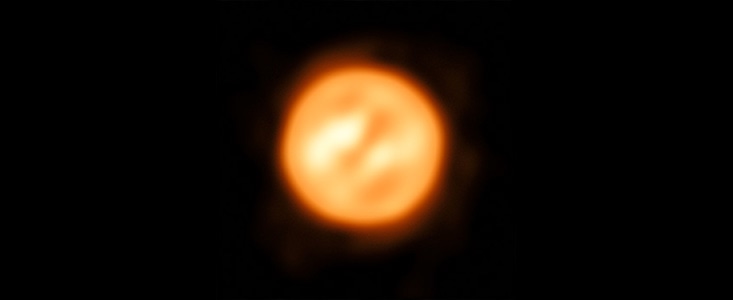Aug 24 2017
Antares, the famous, bright star, shines to the unaided eye with a strong red tint in the heart of the constellation of Scorpius (The Scorpion). This star is a huge and relatively cool red supergiant star in the late stages of its life, on the way to becoming a supernova.
 Using ESO’s Very Large Telescope Interferometer astronomers have constructed the most detailed image ever of a star — the red supergiant star Antares. They have also made the first map of the velocities of material in the atmosphere of a star other than the Sun, revealing unexpected turbulence in Antares’s huge extended atmosphere. The results were published in the journal Nature. Credit: ESO/K. OHNAKA
Using ESO’s Very Large Telescope Interferometer astronomers have constructed the most detailed image ever of a star — the red supergiant star Antares. They have also made the first map of the velocities of material in the atmosphere of a star other than the Sun, revealing unexpected turbulence in Antares’s huge extended atmosphere. The results were published in the journal Nature. Credit: ESO/K. OHNAKA
A team of Astronomers, headed by Keiichi Ohnaka, of the Universidad Católica del Norte in Chile, have now employed ESO’s Very Large Telescope Interferometer (VLTI) at the Paranal Observatory in Chile in order to map Antares’s surface and then to measure the motions of the surface material. This is considered to be the best image of the atmosphere and surface of any star other than the Sun.
The VLTI is a unique facility capable of merging the light from up to four telescopes, either the smaller Auxiliary Telescopes, or the 8.2 meter Unit Telescopes, in order to develop a virtual telescope corresponding to a single mirror up to 200 m across. This enables it to resolve fine details far beyond what can be seen with just a single telescope.
How stars like Antares lose mass so quickly in the final phase of their evolution has been a problem for over half a century. The VLTI is the only facility that can directly measure the gas motions in the extended atmosphere of Antares — a crucial step towards clarifying this problem. The next challenge is to identify what’s driving the turbulent motions.
Keiichi Ohnaka, Chief Author of the Paper
The team used the new results and produced the first two-dimensional velocity map of the atmosphere of a star other than the Sun. This was done by using the VLTI along with three of the Auxiliary Telescopes and an instrument known as AMBER in order to produce separate images of the surface of Antares over a small range of infrared wavelengths.
These data were then used by the team for calculating the difference between the average speed over the whole star and the speed of the atmospheric gas at varied positions on the star. This developed a map of the relative speed of the atmospheric gas across the whole disk of Antares — considered to be the first ever developed for a star other than the Sun.
The team discovered low-density, turbulent gas much further from the star than expected, and determined that the movement could not result from convection, that is, from large-scale movement of matter which transmits energy from the core to the outer atmosphere of several stars. The Astronomers explain that a new, currently unknown, process may be required for explaining these movements in the extended atmospheres of red supergiants such as Antares.
In the future, this observing technique can be applied to different types of stars to study their surfaces and atmospheres in unprecedented detail. This has been limited to just the Sun up to now. Our work brings stellar astrophysics to a new dimension and opens an entirely new window to observe stars.
Keiichi Ohnaka, Chief Author of the Paper